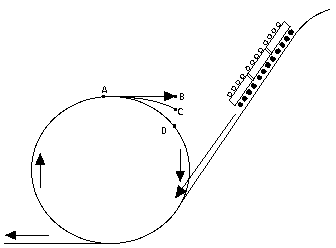|
Suddenly the bus makes a sharp turn, following part of a circle of radius r. If the passenger's body is to stay in the seat as before, an extra force must be added, to keep it from continuing in a straight line (its natural tendency). If ru is a unit vector (unit vectors are defined in the preceding section) directed outwards from the center of rotation, along the radius r, the force F2 exerted by the seat must increase to provide the centripetal force
–(mv2/r)ru that makes the passenger follow the motion of the bus:
F1+ F2 = – (mv2/r) ru
The bus and the seat now constrain the passenger's body to follow part of a circle, and to do this must pull it towards the center. To stay in place (that is, balance the above equation), F2 on it must be increased by an additional force in the direction of –ru, towards the center of the curve.
How does this same event look in the frame of the bus? Adding (mv2/r)ru to both sides of the equation gives, in a similar way to what was done before
F1+ F2 + (mv2/r) ru = 0
Equilibrium is attained and the passenger stays in place, if the equation above is satisfied. This can be viewed as the equilibrium between 3 forces--
F1, F2
and the centrifugal force (mv2/r)ru directed along ru, radially outwards.
This can easily be generalized to any frame of reference moving around a circle:
|

